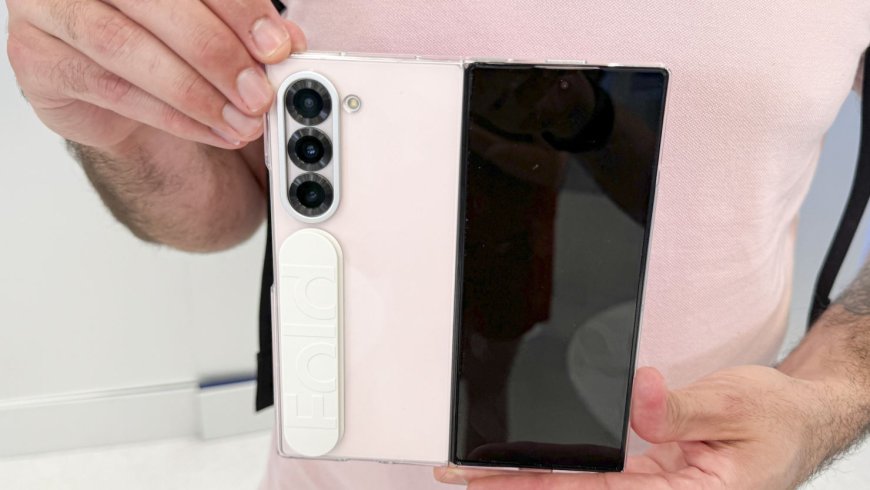Samsung’s AI-powered foldable phones get slimmer, thinner, pricier

Samsung’s latest generation of foldable phones aim to draw in traditional phone users with the help of artificial intelligence.
At its annual Unpacked event on Wednesday, held in Paris for the first time, the company announced updates to its foldable devices and earbuds, and shared more details about its upcoming smart ring.
The stars of the show, however, are Samsung’s latest foldables phones, now lighter, slimmer and packed with AI tools: the Galaxy Z Fold 6, a smartphone that opens outward like a book to form a tablet, and the clamshell-like Galaxy Z Flip 6, with a design reminiscent of flip phones from the early 2000s.
The company says both devices feature a more durable hinge, better battery life and run on Qualcomm’s Snapdragon 8 Gen 3 processor optimized for AI processing.
These upgrades, however, come with a higher cost. The new Galaxy Z Fold starts at $1,899.99, up $100 from last year, and is available in silver, pink and navy. Meanwhile, the Z Flip starts at $1,099.99 (also $100 more than last year) and comes in silver, yellow, blue and mint. The devices go on sale Wednesday.
Price remains one of the biggest challenges to get consumers on board with foldable smartphones. According to ABI Research, foldable shipments reached 20 million in 2023, which is likely to improve to around 28 million units in 2024, or less than 3% of total shipments.
David McQueen, a research director at ABI Research, believes foldable displays will also find their way into other mobile products, such as tablets, laptops, and smartwatches over the coming years, but most manufacturers are currently focused on getting consumers comfortable with foldable phones.
“While the user experience of foldable devices has improved through each new iteration, the sector has still yet to fully convince consumers of the improved use cases, tactile benefits, and the added functionality of a foldable product,” he said.
Ahead of the event, TM Roh — Samsung’s president and head of mobile experience — told CNN the new price is reflective of component costs but could come down more in the future.
"The price depends a lot on how the related technologies develop and how fast they evolve in the future,” he said. “We do believe it will take time (for the prices to drop), so as of now we are focusing more on the premium aspects.”
Roh also believes its Galaxy AI software will continue to keep its foldable line a market leader, at a time when other flip and fold models from companies such as Google, Huawei and Motorola roll out compelling options. Samsung’s foldable line occupies between 80% and 85% of the market share. (Some expect Apple to launch a foldable iPhone in the next few years).
In addition to a lighter design, the latest Galaxy Z Fold 6 goes up in size to a 6.3-inch cover screen, up slightly from 6.2 inches, to help enhance user productivity. At the same time, the Galaxy Z Flip 6 has a new 3.4-inch Super AMOLED screen and camera system, featuring a 50MP wide lens that supports 2 times optical zoom and 12MP ultra-wide sensors promising more details in pictures.
Samsung’s big AI push
Both the Flip and Fold are packed with new AI tools, including an updated Note Assist feature that enables transcription, translation and summarizing of voice recordings directly in Notes, and live translation for phone calls. Another new feature called Composer from the Samsung Keyboard creates text suggestions based on keywords for email and social media apps, aiming to reflect your tone by analyzing previous posts.
Google’s AI assistant Gemini is also directly built into the phone. Users can say “Hey Google” or swipe the corner of the screen to get help with writing or doing web searches. Other features include a circle to search tool and a feature that provides image options based on simple sketches or drawings when Samsung’s S Pen stylus is used.
AI has been on smartphones for years, such as Siri and Google Assistant, but the new generative AI features seek to improve the overall user experience particularly when it comes to getting work done, according to McQueen.
“The addition of generative AI in smartphones will be key to launching a plethora of AI-powered applications and tools that will help re-stimulate market demand as consumers move from just entertainment to enhanced productivity devices,” he said.
Roh told CNN that AI is deeply integrated into its Galaxy products and that Samsung is also taking a hybrid approach when it comes to privacy, allowing users the option to decide when AI requests are performed directly on the device or in the cloud.
“If privacy is more important to you, or if low latency is more important, someone can use on-device AI instead versus having a higher capacity, greater performance where they can leverage a cloud-based AI,” he said. “We can provide optimal technology given the consumer’s use case so that our devices would no longer be just called the smartphone but more of an AI phone.”
Beyond the foldables

The Samsung Ring brings health tracking to your finger. Jaeyong Park/Samsung
Although Samsung previously teased its smart Ring that’s worn on a finger earlier this year, the company unveiled pricing and new specs related to the device. The ring, which is packed with sensors, offers health monitoring, such as the ability to take your temperature, sleep tracking and personalized insights. The device, which comes in black, silver and gold, will likely go head to head with smart ring market leader Oura. Pricing starts at $399.99 and goes on sale Wednesday.
According to IDC Research, smart rings are the fastest growing segment in wearables, with 29% year over year growth over the next 5 years. Francisco Jeronimo, a VP of data and analytics at IDC, said consumers should be drawn to the product because it’s a “less intrusive” form factor than a smartwatch but still tracks key vitals.
“I wouldn’t be surprised if Apple announced its own ring sometime soon,” Jeronimo said. “Of course it could cannibalize the sales of smartwatches but we don’t think it will be a massive concern.”
That’s because people might prefer to use a smartwatch for its ability to send messages or perform advanced health tracking, such as doing an EKG. But those same people might prefer to sleep with a smart ring on their finger rather than a smartwatch on their wrist.
Meanwhile, the new Galaxy Buds 3, which starts at $179.99, now includes an interpreter mode that allows users to get lectures or meetings translated in real time into other languages. It also adds new control functions for playing or stopping music without needing to physically touch the earbuds.
It comes in white and silver and goes on sale Wednesday.
Source: CNN
























































